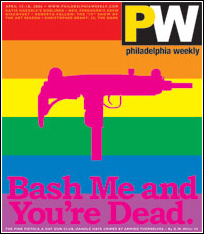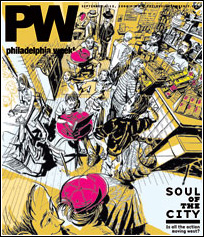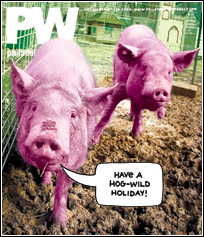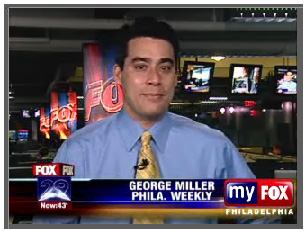West of Eden
Thanks largely to the neighborhood's big institutions, University City is now a great place to live.
From the September 6, 2006 Philadelphia Weekly
There are mothers pushing strollers, young people pushing bicycles and dogs roaming off-leash beside their owners at Clark Park during the twice-weekly Farmer's Market on 43rd Street.
A heavy-set black man reaches into a tray of peaches, picks out a furry fruit, rubs it in his hands and then chomps into the refreshing treat.
"I had to bite it," he tells his friend as he laughs, the juice squirting from his lips. "I just had to!"
He keeps chuckling as he pays the farmer, who smiles in return.
There are older white men with ponytails, pregnant women who look ready to give birth and a lone girl with her right eyebrow pierced, sitting on a bench near the market, wearing a brown dress with white polka-dots, typing on a laptop computer. A grungy homeless man sleeps on an adjacent bench, his tattered clothes and soiled shoes lying on the ground beneath him.
A thin Asian man wears his dress pants hiked up to his elbows. Two grey-haired men shuffle through the crowd, their hands clasped in an intimate embrace. A mom and her teenage son sort through ears of corn, both of them with baseball mitts tucked under their arms.
There are dashikis and sarongs, Army fatigues, dreadlocks, straw hats, a retro Phillies cap, shaved heads, Afros and a muscular man in a sleeveless shirt, carrying an umbrella with a skull's head on the handle.
What is glaring, after a while, is what you do not see: there are no suits among the crowd.
The nucleus of University City may be the mammoth University of Pennsylvania, the primary catalyst - positively and negatively - behind the majority of large-scale activity in the area.
But it is Clark Park that represents the ethos of this small pocket of the city.
There are Shakespeare performances, pick-up games of petanque, Uhuru Solidarity Movement sponsored flea markets and annual Charles Dickens' birthday parties. Here, you can find Anarchsists, Somalians, inter-racial couples, Orthodox Jews, Liberians, college students, Europeans, lesbians and Eritreans. Together. Mingling. On just about any day of the week.
This park is the soul of the socially conscious community.
That is why when a Penn researcher, Vladimir Sled, was stabbed to death about one block away from here on Halloween in 1996, this community was incited to take action.
It triggered them to collaborate in a most unprecedented way.
***
What is now considered University City is actually a collection of similar yet distinctive neighborhoods: Spruce Hill, Cedar Park, Powelton Village, Garden Court, Squirrel Hill, West Powelton and Walnut Hill, as well as the vast university campuses.
Shortly after Sled's murder, the neighborhood associations, politicians and major institutions in the area all met at the table for the first time ever, putting aside long-standing grudges, to explore solutions to the persistent problem of crime in the area.
The result was the 1997 creation of the University City District, a donation-funded special services agency charged with increasing safety, assisting residents and businesses, keeping the area clean and promoting the attractions of the colorful 2.2 square mile neighborhood.
"Ten years ago, we [University City] were known for crime, for being dirty," says Lori Klein Brennan, UCD's senior director of marketing and communications. "Nobody wanted to come here."
Things have changed dramatically since the formation of the District.
Overall crime has dropped around 43 percent. Hundreds of new people have purchased homes here. Two-dozen cultural organizations have moved to the area. Numerous businesses have opened shop and large-scale development is underway mimicking that of Center City - from the gleaming Cira Center to the pending Dock Street Brewery.
"Never did we have private development interest like we have now," Brennan adds.
Barry Grossbach, a 36-year resident and three-time president of the Spruce Hill Community Association, says, "We are in debt to Vladimir Sled for the serious changes that have happened here."
***
Sled, a Russian native known to his friends as Volodya, and his Swedish fiancee Cecilia Hagerhall were walking home from their Penn research lab around 11 pm that Halloween.
As biochemists, they regularly worked long hours and they often checked on experiments in the middle of the night. Afterwards, they always walked back to their home at 4405 Osage Avenue. That's why they lived in a neighborhood that they had been warned was dangerous: it was close to work. It appealed to their European sensibilities.
They were around the corner from their home, standing where thousands of costumed, candy-loving children had scampered about only hours before, when a man jumped out of nowhere and tried to steal Hagerhall's purse.
Sled, who had celebrated his 38th birthday three days earlier, refused to release the bag and a struggle ensued. An accomplice arrived, stabbed Sled and ran off with the purse.
Sled was left crumpled in a pool of blood.
"We didn't know anybody living on Larchwood Avenue where the attack took place but in only a few minutes, several people responded to my cries for help," Hagerhall writes from Sweden where she now resides. "They left the safety of their homes and came running to assist us."
But Sled died less than an hour later.
The senseless death was the culminating tragedy in what had already been a bizarre semester at Penn.
There had been 30 armed robberies on or around the campus in September alone. A local activist had immolated herself in front of the main library. And a Penn senior was shot during an attempted robbery while walking home from Smokey Joe's, the college hangout.
Parents were already clamoring for action.
"More than one person called us up or e-mailed us or said in a protest session, 'Put a damn fence around the campus,'" says John Fry, former executive vice-president of Penn and now the president of Franklin & Marshall College.
And then Sled was killed.
City councilwoman Jannie Blackwell reached out to Penn president Judith Rodin.
"Listen, this is major," Blackwell says she told Rodin. "He lives in the community but he works on your campus and therefore, we need to be united."
Blackwell offered to meet Rodin on campus. But Rodin, a West Philadelphia native and Girl's High graduate, told Blackwell that she would go one step further and organize a candlelight vigil from the campus to Sled's home.
Within days, Penn, Drexel, the University of the Sciences, the Science Center, the community groups and politicians began formulating plans to reverse the downward slide.
***
"My job is to be the eyes and ears of the community," says Eugene Blackson. "And keep the place clean."
The 47-year old former SEPTA bus driver is radiant in his yellow UCD shirt, slowly cruising along Chestnut Street on a gun-metal grey mountain bike. As one of the 34 UCD ambassadors - unarmed safety patrols - he glances in a different direction every few seconds, constantly observing the scene.
One of the primary functions of the UCD is to have a reassuring presence - to aid the residents and police - and Blackson is part of the effort.
He rides up 39th Street, goes west on Ludlow and north on 41st to Market. He spins through a parking lot that has been known for trouble in the past. He goes east on Market, drops down 34th Street, turns east on Walnut and then stops suddenly at 33rd.
"FYI," he says into his two-way radio. "There is graffiti on the back of the 'No turn on red' sign on the northwest corner of 33rd and Walnut."
He writes up the paperwork and then states, "They'll come out here and clean it off. It will probably be gone next time I loop around."
He pedals off, north on 33rd, then right on Market and then over to 30th Street Station. He dismounts and walks his bike through the crowded terminal.
During the one year that he has been an ambassador, Blackson has aided a woman who locked her keys - and her infant strapped in the baby-seat - in her car. He stumbled across a fist-fight between a car owner and the thief who broke into the car ("The thief was calling for me to help him!" Blackson laughs). He has escorted numerous people safely home. And a few weeks ago, he gave confidence to an elderly woman who was scared to walk the street.
"Three young boys were walking towards her when she was coming out of her house," he says. "She was scared, about to go back in, but she saw me coming on my bike. She walked out and said, 'Thank you.'"
He weaves through cab drivers outside the train station and head's towards Drexel's campus. He spots more graffiti, near 32nd and Filbert, and calls it in. At 36th and Market, he finds a shuttered newsstand that has been tagged multiple times.
"You wouldn't believe how much graffiti will mess up somebody's business, deter people from going inside," Blackson says while looking at the adjacent office buildings. "The main thing is to make University City safe. If they can bring people in, that will make it safe, and that brings in other people."
Police, who have a substation adjacent to the UCD office at 40th and Chestnut, are reluctant to give too much credit to the ambassadors but crime is decidedly reduced from before the UCD's existence.
In the District in1996, police recorded 5,500 major crimes - from homicides and rapes to point-of-gun robberies and aggravated assaults.
In 2005, there were 3,158 total.
"Since 1996, every crime category has decreased," says John Fenton, the UCD's director of operations.
Rapes, murders, point-of-gun robberies and burglaries are all down this year compared to the same period in 2005, according to Philadelphia police department statistics.
"Safety is one of the fundamental building blocks," says UCD executive director Lewis Wendell, whose grandfather was a catcher for the Phillies in the 1920's. "Before you can have anything else, you have to have clean and safe."
***
"You're not just buying a house," says Tom Lussenhop, a private developer and former managing director of Penn's real estate division. "You're buying a neighborhood, too."
This spring, Lussenhop built 9 condos - 6 in a new building and 3 in an adjacent, renovated rowhome. They sold out about six months before they were finished.
"I had no doubts there was a very solid market for new housing," he says.
He believes they are the first new, privately-developed homes constructed in the neighborhood since the 1960's. And he has plans for more projects in the neighborhood. Ten years ago, however, he says he couldn't imagine a project like his occurring here.
University City was in a situation many urban universities were facing in the mid-90's - the steady cycle of poverty in the surrounding area: few employment opportunities, drugs, crime, poor public education.
There were fears among the universities that top quality students and faculty would select other institutions in environments perceived to be safer.
The UCD stepped in to address the quality of life crimes, putting 300 new lights around the District, placing trash cans on street corners and bicycle racks at strategic locations. They employed a team of 26 maintenance workers to sweep the streets and sidewalks and remove graffiti.
In 1997, Penn began offering a mortgage assistance program to employees who moved to the neighborhood. Because of that program alone, more than 400 families have moved to the area.
The average home sale price rose from $78,472 in 1995 to $292,222 in 2005.
And the area has retained its blend of cultures and liberal values.
"I don't see a Republican takeover of the neighborhood," says Mike Hardy, a board member of the University City Historical Society and a founding member of the Friends of Clark Park. "The people that are coming here are the kind of people who embrace the spirit of the community."
In 1998, an unusual partnership between Penn, the School District of Philadelphia and the Philadelphia Federation of Teacher's created the Penn Alexander School, a high quality elementary school in the very center of the District. The school has helped retain families who previously would have moved to the suburbs when their children reached school age.
"It has become a lot easier nowadays to recruit outstanding faculty from other cities, even from Boston, Atlanta, Miami and the state of California," says George Tsetsekos, dean of Drexel University's LeBow College of Business. "The city is not a negative issue anymore. Actually, it is an attracting point."
***
"There certainly was a period when Penn behaved as if it were in the community but not of the community," says Penn professor Ira Harkavy, the founding director of the Penn Center for Community Partnerships. "And they viewed West Philadelphia as a problem rather than a community that we should work in partnership with. Penn behaved in arbitrary fashion to actually separate itself from the community."
This notion peaked in the 1960's when Penn led the other major institutions in the formation of the West Philadelphia Corporation - which received no input from community residents - and began bowling through crumbling but long-established neighborhoods, most of which were predominantly black.
That caused a major lack of trust within the community.
"It was universities trying to swallow up neighborhoods," says councilwoman Jannie Blackwell.
By that time, the majority of the wealthy people had left their ornate Victorian mansions in West Philadelphia. The homes were chopped up into multi-unit rentals and left to deteriorate. Many students, faculty and staff moved to Center City and beyond rather than live in fear in University City.
A new breed of urban pioneers - artists, conscientious objectors to the Vietnam War and other socially disenfranchised people (black, gay, liberal intellectuals, etc) - moved into the stately homes. They basked in the diversity and tolerance of the area and they established the foundation that remains today.
In 1983, Penn president Sheldon Hackney changed the West Philadelphia Corporation to the West Philadelphia Partnership and invited residents to participate in the shaping of their own communities.
That marked the beginning of a new era.
***
"The word 'gentrification' gets thrown around so much it doesn't even make sense anymore," scoffs Gail Fisher, the UCD's commercial corridor manager, while strolling along Baltimore Avenue.
Fisher walks the strip several days per week, talking to business owners about ways to improve the area. UCD offers matching grants up to $10,000 to businesses that spruce up their storefronts, and Fisher helps with design. Fourteen businesses have taken advantage of the service in the last two years alone.
"This is fairly unique to University City," says Carolyn Blackwell, UCD's director of neighborhood initiatives. "We provide clean and safe and we provide business services."
There are painted facades with large windows and colorful displays along the strip now, and several more businesses are on the way. A sign maker is moving in from New Jersey. Dock Street Brewery is opening at 50th Street. A new state liquor store has been approved.
In 2003, when Roger Harmon was planning his restaurant, Abbraccio, just off Baltimore Avenue near 47th Street, he had a hard time finding a bank to lend him the money.
"We were turned down by 80 financial institutions," he laughs.
The UCD vouched for Harmon, a former economist with 25 years in the restaurant business. And when the last bank finally gave in but only lent half the amount needed, the UCD helped Harmon find smaller loans from various groups.
"I owe so many people, it's ridiculous," he says.
His Italian eatery with a large wrap-around porch and seating for 160 is now a focal point in the community. He even offers a Sunday brunch special that kicks back a percentage of the price to community groups.
"I think we have the most diverse clientele of any restaurant in the city," he says.
***
Penn contributes $1.6 million to the UCD's operating budget of around $5.7 million. The Penn Health System, which is separate from the university, throws in another $600,000. The remainder of the money comes from the other major institutions in the area - Drexel, the Science Center, Children's Hospital, the University of the Sciences - and from foundation grants and private donations.
"Every contributed dollar that goes to the University City District is a voluntary dollar," says John Fry, who helped shape the UCD while at Penn. "No one is being compelled. There is no formula."
Fry points out that the major institutions have their own security and maintenance staff, so they don't use UCD services on their campuses.
"Basically, all the services are paid for by the institutions," he says, "And all the services are provided to the neighborhoods."
***
"Maybe next year," says Jared Reed, co-artistic director of the Curio Theatre Company.
He lovingly looks around the degenerating shell of the once grand sanctuary at Calvary Methodist Church at 48th Street and Baltimore Avenue. The ceiling is cracked, the plaster is peeling off the walls and the faux-marble columns are crumbling. At the front of the room is a 3,000 pipe organ where Reed imagines future performance space. Some of the pews are shoved off to the side to make way for the anticipated repairs.
"It's not about preserving the space as a church," he says. "It's about creating a community cultural resource."
Reed, a Julliard-trained performer, and his partners approached the UCD when they were looking for a place to call home in 2005. Curio had been a traveling troupe, performing in England and across the United States, with temporary facilities in Delaware County. The UCD took Reed to Calvary.
Here, they found an interesting mix of people: low-power FM radio activists, international musicians, the University City Historical Society, Alcoholics Anonymous and people of multiple faiths. They also found a temporary performance site in the chapel and a future home in the sanctuary.
"They were just looking for an excuse to renovate this room," Reed says.
It is roughly a $1 million job but $200,000 will make the room safely functional. Ten years ago, no one could have predicted that this structure, built in 1906, would be an anchor in the community.
For three years in the mid-90's, the dilapidated building was listed for sale with no takers. The closest it came to selling was when a Chicago millionaire attempted to buy the two 28-feet tall, 22-feet wide Tiffany stained-glass windows and two ornate, stained-glass domes.
When community groups learned of the sale, they freaked out.
"You don't want us to sell the building, what do you want to see happen here?" asked Rich Kirk, president of the Calvary Center for Culture and Community, as the site is now known.
They wanted community space, cultural amenities and to continue being a house of worship.
Now, Calvary houses 14 organizations including a revolving door of religions.
There are separate services for Methodists, Mennonites, two different Pentecostal congregations, Quakers and Jews. A progressive Muslim group plans to start meeting here soon. Ethiopian Mennonites, Liberians and an LGBT group have recently inquired about holding services.
"We just don't have any more room on Sundays," says Kirk, a University City resident since 1972.
The center is alive with diversity - of faiths, ethnicities, sexual orientations and races. Just like University City itself.
"It's a thought-out ethos here - why shouldn't this group be a part of the neighborhood?" says Kirk. "I don't know many places where you can get that level of conversation."








